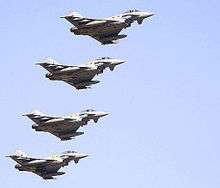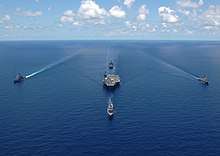Expeditionary warfare
Expeditionary warfare is the deployment of a state's military to fight abroad, especially away from established bases. Expeditionary forces were in part the antecedent of the modern concept of rapid deployment forces. Traditionally, expeditionary forces were essentially self-sustaining with an organic logistics capability and with a full array of supporting arms.
| Part of a series on |
| War |
|---|
|
|
|
Related
|
In the ancient world

The earliest examples of expeditionary warfare come from the Sea Peoples, a term used for a confederation of seafaring raiders of the second millennium BC who sailed into the eastern shores of the Mediterranean, caused political unrest, and attempted to enter or control Egyptian territory during the late 19th dynasty, and especially during Year 8 of Ramesses III of the 20th Dynasty.

The raiding tactics were expanded into the more complex expeditionary warfare operations by Alexander the Great who used naval vessels for both troop transporting and logistics in his campaigns against the Persian Empire.
The next exponents of expeditionary warfare in the ancient world of the Mediterranean Basin were the Carthaginians who introduced two entirely new dimensions to the use of naval forces by staging not only operations that combined naval and land troops, but also eventuated in combining strategic multi-national forces during the land phase of the operation when Hannibal in his most famous achievement at the outbreak of the Second Punic War marched an army, which included war elephants, from Iberia over the Pyrenees and the Alps into northern Italy.
Following on the example of Carthage, the Romans used expeditionary operations extensively to expand their Empire and influence in the Mediterranean and beyond, including the Roman conquest of Britain which was not only a limited expeditionary operation, but one conceived to include long-term occupation and Roman settlement of the territories.
In the Middle Ages
Shortly after the collapse of the Roman empire in Italy, the European Middle Ages began with an expedition of imperial Byzantine general Belisarius against the Vandals. But as that empire dwindled, its warfare became more defensive.
The most prominent development of expeditionary warfare during the European Middle Ages came from the environmental pressures in the Scandinavian region during the Middle Ages, and the emergence of the Viking migrations that combined raiding, longer term inland operations, occupation and settlement. These operations were conducted as sea, coastal and riverine operations, and sometimes were strategic in nature, reaching as far as Constantinople.
Expeditionary warfare in East Asia began very much in the same way it had in the Mediterranean with short-term raids by Japanese pirates. Because the Wokou were weakly resisted by the Ming Dynasty, the raiding eventually developed into fully-fledged expeditionary warfare with the Japanese invasions of Korea (1592–1598).
During the Crusades
The development in expeditionary operations reached a new level when during the Crusades the element of political alliance as an influence on the military strategy was introduced, for example in the Sixth Crusade (AD 1228.)
The rise of European Colonial Empires
Although all expeditionary warfare until the invention of the combustion engine was largely dependent on the sailing vessels, it was with the creation of sophisticated rigging systems of the European Renaissance that the Age of Sail allowed a significant expansion in expeditionary warfare, notably by the European colonial empires. Some have argued that this was the first revolution in military affairs that changed national strategies, operational methods and tactics both at sea and on the land. One notable example of this evolution was the French Invasion of Egypt (1798).
Though a significantly expanded expeditionary operation, the Crimean War was the first example of a planned expeditionary campaign that was directed as part of a multinational coalition strategy. Aside from being the first modern expeditionary operation that used steam powered warships and telegraph communications which marked it as the departing point for the rest of the 19th and 20th century developments. It was also the first used as a military theatre instrument to force decision in the conflict, in what proved to be the last use of the sailing vessels in military expeditions.

Perhaps unique in the development of expeditionary warfare were the operations by Yermak during the Russian conquest of Siberia which was a largely land-based operation. This eventually led to the Russian settlement of the Far East and the coast of the Pacific Ocean.
The next development in the evolution of the expeditionary warfare was made during the expansion of the western European Empires and the era of colonialism that also led to the inclusion of the expeditionary methods into the direct expression of national strategies to avoid full-scale conflicts in the shape of the gunboat diplomacy approach. It was at this time that naval troops previously used almost exclusively for defence of vessels or minor beach operations were expanded to enable extended littoral operations. The colonial experience, though largely confined to the period before the First World War, persisted well into the 20th century.
Unique in this period was the emergence of non-empire building multinational (though not coalition) operations to defeat the Boxer Rebellion by the Eight-Nation Alliance that can be categorised as possibly the first peacekeeping operation in the modern era.
Perhaps the best example of the empire-building application of the expeditionary warfare were the conflicts between the British Empire and the Boer settlers in South Africa, and the resulting First and Second Boer Wars.
The World Wars
First World War
The period of the First World War that prolonged well past its completion into the 1920s saw expeditionary warfare established as a systematic and planned type of operations with larger scope than simple transportations of troops to the theatre such as the British Expeditionary Force in 1914, Russian Expeditionary Force in 1916, and the American Expeditionary Force in 1917, and the beginnings of development in true combined operations at strategic, operational and tactical levels with the unsuccessful amphibious landing at Gallipoli. Not only did this operation combine the elements of overall war planning context, multinational deployment of forces as part of the same operation, and use of troops prepared for the landings (as opposed to disembarkation), as well as naval gunfire support that was only limited during the era of sailing ships, but also included extensive use of combat engineering in support of the infantry. One of the most extensive and complex of expeditionary operations that followed the war was the Allied intervention in the Russian Civil War that saw forces deployed in the Baltic region, the Arctic region, along the Black Sea coast, and in the Russian Far East.
.jpg)
Other expeditionary forces during WWI included:
- Australian Naval and Military Expeditionary Force (Pacific)
- Belgian Expeditionary Corps in Russia 1915–1918
- Canadian Expeditionary Force 1914–1920
- First Australian Imperial Force (Europe)
- Indian Expeditionary Force 1914–1918
- South African Overseas Expeditionary Force 1915–1919
- New Zealand Expeditionary Force 1914–1918
- Portuguese Expeditionary Corps 1917–1918
- Siamese Expeditionary Force 1917-1918
Second World War
_in_France_1939-1940_O87.jpg)

Contemporary
European Union
United Kingdom

- 3rd Division (United Kingdom)
- 16 Air Assault Brigade
- 3 Commando Brigade
- Joint Expeditionary Force (Maritime)
- UK Joint Expeditionary Force
- Combined Joint Expeditionary Force
- Joint Rapid Reaction Force
- No. 83 Expeditionary Air Group
- No. 901 Expeditionary Air Wing
- No. 902 Expeditionary Air Wing
- No. 903 Expeditionary Air Wing
- No. 904 Expeditionary Air Wing
- No. 906 Expeditionary Air Wing
- Expeditionary Air Wing
- No. 34 Expeditionary Air Wing
- No. 38 Expeditionary Air Wing
- No. 121 Expeditionary Air Wing
- No. 135 Expeditionary Air Wing
- No. 138 Expeditionary Air Wing
- No. 140 Expeditionary Air Wing
United States

- Carrier Strike Group
- Carrier Strike Group One
- Carrier Strike Group Two
- Carrier Strike Group Three
- Carrier Strike Group Five
- Carrier Strike Group Eight
- Carrier Strike Group Nine
- Carrier Strike Group Ten
- Carrier Strike Group Eleven
- Carrier Strike Group Twelve

- Expeditionary Strike Group
- Marine Expeditionary Force
- Marine Expeditionary Brigade
- Marine Expeditionary Unit
- List of Air Expeditionary units of the United States Air Force (43 of them)
See also
References
External links
- Response Force Task Group (RFTG) (Royal Navy PDF)